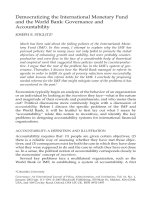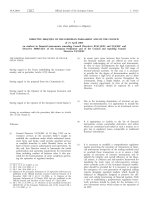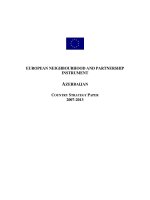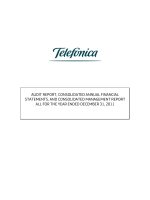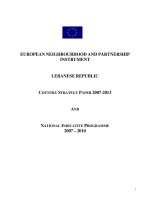European Fund and Asset Management Association (EFAMA) ppt
Bạn đang xem bản rút gọn của tài liệu. Xem và tải ngay bản đầy đủ của tài liệu tại đây (82.61 KB, 19 trang )
Prepared for:
European Fund and Asset Management Association
(EFAMA)
October 2011
Strategic Insight, an Asset International Company
© Copyright 2011
FUND FEES IN EUROPE:
ANALYZING INVESTMENT MANAGEMENT FEES,
DISTRIBUTION FEES, AND OPERATING EXPENSES
Fund Fees in Europe October 2011
2
Recognition
This report was commissioned by the European Fund and Asset Management Association
(EFAMA). We are grateful for the input of the EFAMA TER working group members:
Massimo Tosato (Chair) – Executive Vice Chairman, Schroders
James B. Broderick – Head of Europe, J.P. Morgan Asset Management
Fabio Galli – Director General, Assogestioni
François de Looz – Global Head of Risk Management, Compliance & Legal – BNP
Paribas (Asset Management)
Markus Miederhoff – General Counsel (Europe), Allianz Global Investors
Laurent Ramsey – Chief Executive Officer, Pictet Funds
Fund Fees in Europe October 2011
3
Table of Contents
Executive Summary 4
Key Findings 5
European Funds: Total Expense Ratio Deconstructed 7
Total Expense Ratio by Fund Type and Distribution Channel 7
Management Fees: Shared with Distributors, Retained by Fund Managers 8
Fee and Expense Dynamics in Europe: Moving Forward 9
European Fund Fees in Contrast to the U.S. Market 11
Management Fees and Expenses: Europe and the U.S 12
Annual Asset-Based Fees and Commissions: Beyond TER 13
Conclusions:
Looking Ahead 15
Appendix:
Methodology 16
Report Authors 18
About Strategic Insight 19
EFAMA European Fund Fee Survey Results 2011 ~ Retail Summary 20
Fund Fees in Europe October 2011
4
Executive Summary
Today shareholders have access to mutual fund expense information via point of sale documents,
prospectuses, fund company websites and external data providers. While these sources allow
fund shareholders to determine the total expense ratio (‘TER’), deconstructing that ratio to fees
collected by distributors, administrators and custodians, and what is retained by fund
management is not possible through current disclosure.
The need to cover distribution costs through retrocessions from fund management fees, a model
that is not unique to Europe but seen in many markets around the world, reflects the realities of
how funds are offered to retail investors. Yet the bundling of distribution and investment
management fees has made it more difficult to understand the costs charged by the various types
of organizations in the fund value chain, and at times led some market observers to
mischaracterize fees allocated to investment management. Data made available to Strategic
Insight (‘SI’) in the EFAMA members’ survey provides valuable information about the various
components of investment management fees and the total expense ratios.
Seventeen EFAMA corporate members, accounting for over EUR 1 trillion in EU-domiciled
equity and bond funds as of year-end 2010, were surveyed for this report. These larger
companies all distribute cross-border and operate in multiple jurisdictions. Our analysis
benchmarks how much of European funds’ TER are paid to investment managers, fund
distributors and other service providers (e.g. fund administrators, custodians). The data are
aggregated by fund type and distribution channel. Additionally, European fund fees are
compared to those of U.S. mutual funds.
The study shows that, on average, UCITS fund managers retain just 42% of TERs. Through
retrocessions, distributors are paid 41% of the total expense ratio. The balance of 17% is used for
operating services such as custody, administration, transfer agency, etc. Fund managers still must
assume the cost of marketing, supporting and servicing distribution organizations, all paid out of
the remaining net management fees.
When studying the difference in TER between European and U.S. retail funds, SI suggests that
the disparity is significantly explained by economies of scale as well as by taking into account
the increasing use of “wrapper” fees in the U.S. that are charged in addition to the TER. These
considerations provide a more accurate comparison of total investor costs in Europe and the U.S.
The study shows that asset-weighted average net investment management fees in Europe are
only about 3 basis points greater than management fees in the U.S. when excluding the three
largest U.S. fund managers (managing $600 million to $1 trillion each).
Fund Fees in Europe October 2011
5
Key Findings
In Europe, a retail equity fund shareholder pays about 175 basis points in average total
annual expenses (reflected by the TER) and a retail bond fund shareholder pays about
117 basis points annually.
TER allocations: fund managers retain 42% of TER. Through retrocessions, distributors
are paid 41% of the total expense ratio. The balance of 17% is used for operating services
such as custody, administration, transfer agency, etc.
Management Fee allocations: Within the bank and insurance distribution channels, stock
and bond fund managers retain on average 47% and 45% of annual management charges
(AMC) as net investment management fees, respectively. A greater proportion, 53% and
55% respectively, is paid to distributors through retrocessions. Among survey
participants, the bank and insurance distribution channels account for nearly 75% of
assets.
After fee retrocession to distributors, net investment management fees retained by
European mutual fund managers average roughly 74 basis points (asset-weighted) among
retail actively managed equity funds and 49 basis points among bond funds.
Asset-weighted average net investment management fees in Europe are only about 3
basis points greater than management fees in the U.S. when excluding the three largest
U.S. fund managers (managing $600 million to $1 trillion each). The influence of these
mega firms distorts the composite asset-weighted results often used to compare smaller
firms. Additionally, one of the managers applies an at-cost pricing model in setting fees
for its fund line-up. Even when including these mega sized managers, management fees
in the U.S. are approximately just 11 basis points less than net management fees in
Europe.
Over 50% of U.S. fund sales through Financial Advisors (FAs) were enabled by asset-
based fees of 1.0-1.5% charged in addition to the funds’ TER. This is important to note
when comparing European funds’ TERs to U.S. TERs and total shareholder costs.
As the European fund industry expands and matures, operational efficiencies should
enable the reduction of fund expenses. Such evolution could be helped through greater
clarity and transparency of retained net investment management fees versus
distribution/advisory charges. In particular, UCITS IV promises to facilitate scale
efficiencies through cross-border mergers and master-feeder structures, although key tax
barriers are yet to be addressed. Meanwhile the UK’s Retail Distribution Review (RDR),
ban on commissions, and shift towards advisor charging models are prompting the
creation of new lower fee funds. The RDR echoes a worldwide trend in regulatory
Fund Fees in Europe October 2011
6
thinking, seen in markets such as Australia, India, and the U.S., which is expected over
time to influence EC level initiatives and thus affect fee trends in Europe more broadly.
Fund Fees in Europe October 2011
7
European Funds: Total Expense Ratio Deconstructed
TERs: UCITS managers participating in the survey on average retain 42% of TER. Through
retrocessions, distributors are paid 41% of the total expense ratio. The balance of 17% is used for
operating services such as custody, administration, transfer agency, etc.
Annual management charges (AMC): within the bank and insurance distribution channel,
stock and bond fund managers retain on average 47% and 45% respectively as net
investment management fees. A greater proportion, 53% and 55% respectively, is paid to
distributors through retrocessions. Among survey participants, the bank and insurance
distribution channels account for nearly 75% of assets.
The following summary statistics have been derived from survey data submitted to SI. The
aggregates below include European-domiciled stock and bond registered investment funds. The
exclusions listed in the methodology section of the report (page 17) apply.
Total Expense Ratio by Fund Type and Distribution Channel
For the five fund types, the asset-weighted average total expense ratios are:
Equity ~ 1.75% Absolute Return ~ 1.59%
Bond ~ 1.17% Alternative/Others ~ 1.54%
Balanced/Asset Allocation ~ 1.42%
Across the four major European distribution channels analyzed in our survey, asset-weighted
average total expense ratios were nearly the same:
Bank ~ 1.50%
IFA/Advisor ~ 1.50%
Platform ~ 1.54%
Insurance ~ 1.53%
Banks remain the key channel for distribution across most of Europe, although the IFA/Advisor
channel is the predominant one in the UK, and insurance represents an important share in
markets such as France, Spain and Switzerland. Given the variation among clients and products
across markets and channels, the similarity of total expense ratios is notable.
Fund Fees in Europe October 2011
8
Management Fees: Shared with Distributors, Retained by Fund Managers
The survey data shared by EFAMA members segments total expense ratios into three buckets:
(1) management fees, (2) distribution retrocessions, and (3) administrative / other expenses
which include, but are not limited to, client administration, accounting, custody, and transfer
agency fees. The segmentation provides a transparent understanding of the cost drivers affecting
fund total expense ratios, more specifically net retained AMC or net investment management
fees.
As disclosed in fund documents, the AMC (an underlying component of TER) includes both
management fees and payments made for fund distribution. The SI survey provides a unique
opportunity to better understand and benchmark payments made to fund distributors vs. retained
management fees (i.e. portfolio management and securities selection).
Note that fund managers still must assume the cost of marketing, supporting and servicing
distribution organizations. This cost is paid out of net management fees. With rising levels of
support demanded today by distributors, an increasing share of the AMC, beyond the portion
paid out in the form of distribution retrocessions, are thus being used for marketing and sales
functions.
For the four distribution channels, the asset-weighted average annual management charges are
split between fund managers and fund distributors as follows:
Distribution Channel
% Retained by Fund
Manager
% Retrocession to
Distributor
Bank 47% 53%
IFA/Advisor 56% 44%
Platform 54% 46%
Insurance 45% 55%
For the five fund types, the asset-weighted average annual management charges are split between
fund managers and fund distributors as follows:
Fund Type
% Retained by Fund
Manager
% Retrocession to
Distributor
Equity 51% 49%
Bond 52% 48%
Balanced/Asset Allocation 45% 55%
Absolute Return 52% 48%
Alternative/Other 52% 48%
Fund Fees in Europe October 2011
9
Fee and Expense Dynamics in Europe: Moving Forward
The structure and levels of fund fees and expenses in the European industry is the outcome of
many years of evolving dynamics between local European and cross-border market participants,
banks and other financial product distributors, investor needs and their behavior, and regulatory
guidance. The need to cover distribution costs through retrocessions embedded in fund
management fees, a model that is not unique to Europe but seen in many markets at various
stages around the world, reflects the realities of how funds are offered to retail investors.
As the fund industry entered its second phase of development in the late 1990s—primarily
around cross-border European and, increasingly, international distribution of UCITS funds based
in Luxembourg, Ireland and some other domiciles—the need to remunerate distributors and
accommodate retrocessions in various channels and markets played a large role in influencing
the level of fund fees. The bundling of distribution and investment management fees resulted in
an often misunderstood view of the costs charged by the various types of organizations in the
fund value chain. This lack of fee transparency at times led some market observers to
mischaracterize fees allocated to investment management.
Regulators and legislators tried to address this lack of transparency and bundling of distribution
with changes to the rules on selling. The Markets in Financial Instruments Directive (MIFID)
passed in 2004 and implemented by member State regulators in 2007 was a first step in
introducing rules on inducements. Some Member States went further than the Directive
requirements of increased disclosure as they actively sought to ban certain types of inducement,
an example being Italy where CONSOB’s interpretation of the directive meant that distributors
who were operating portfolio management services or fund of funds were no longer able to take
a retrocession from the third party product provider.
In the coming years, various forces will impact the landscape of European fund management and
distribution and influence how fund fees and expenses are charged. Among a few of the
considerations:
Expectations of greater transparency, magnified following the financial crisis of 2007-
2008, are driving greater fee disclosure. As this process unfolds, the European fund
industry is moving towards greater clarity and transparency of investment management
versus distribution/advisory charges. This trend is reinforced by the European
Commission’s initiative on Packaged Retail Investment Products (PRIPs), aiming for a
more consistent approach to product disclosure and selling processes for UCITS, non-
harmonized investment funds, structured products, and investment linked insurance
contracts.
The Commission has announced a review of MIFID and recently consulted again on the
issue of inducements. The consultation raised questions regarding the ability of
Fund Fees in Europe October 2011
10
independent advisers to receive commission payments at all, suggesting such payments
could be provided only where an ongoing advisory service was provided. This in many
ways chimes with the UK’s retail distribution review (RDR) and its ban on commissions
for all advisers (not just independents), which is at the centre of the trend to differentiate
between fees for investment management versus fees for distribution as the market shifts
towards advisor charging models, prompting the creation of new lower fee funds, and
funds or separate share classes without embedded distribution retrocessions. While the
structure of fund distribution through IFAs in the UK is very different from the
predominant bank distribution model across Europe, the underlying issues and industry
drivers are similar, thus it is expected that similar forces will be seen on the Continent
over time. The RDR echoes a worldwide trend in regulatory thinking, seen in markets
such as Australia, India, and the U.S., which is expected to influence EC level initiatives
and thus affect fee trends in Europe more broadly.
UCITS IV promises to facilitate scale efficiencies through cross-border mergers and
master-feeder structures, enabling lower investment management fees (although the
cross-border tax barriers to achieving these efficiencies have still to be addressed).
Competition from ETFs and other low-fee investment providers brings additional
downward pressure, along with forces working to promote greater transparency and
unbundling of investment management from distribution fees, as advisory and charging
models evolve. In sum, it is likely that net investment management fees for core products
experience downward pressure. Counterweights at the same time are provided by the
growing complexity of investment management, the trend towards more international and
global allocations, evolving needs for risk-managed outcome-oriented solutions, and
greater emphasis on new types of products (absolute return, total return, other
alternatives, etc.). Finally, the ongoing global demand for quality investment managers
that can justify above-average advisory fees, and the role of performance incentives, adds
another layer in the developing dynamic.
The European fund industry (through UCITS) is at the heart of the growing global fund
management business, though a rising proportion of UCITS assets comes from Asia,
Latin America, and other markets worldwide. As a result, the fee and expense structures
of “funds in Europe” will be affected by trends far beyond Europe.
Fund Fees in Europe October 2011
11
European Fund Fees in Contrast to the U.S. Market
SI’s survey suggests that the average European-domiciled retail equity mutual fund has a total
expense ratio of 1.75% whereas a U.S. retail equity mutual fund has a total expense ratio of
0.95%. As discussed in the following sections, in many cases, the roughly 0.80% difference
between European TER for retail equity funds and U.S. equity funds can be significantly
explained by placement and categorization of “wrapper fees” that are charged in addition to the
TER. Taking into account these additional “wrapper” fees in the U.S. provides a more accurate
comparison of total investor costs in Europe and the U.S. when “all-in” fees (TER plus asset-
based external fees), are considered.
In the U.S. investment management fees average 61 basis points asset-weighted among retail
actively managed equity funds and 45 basis points among retail actively managed bond funds.
Yet a number of mega investment firms, each running over $500 billion of such funds and thus
enjoying significant economies of scale within the single regulatory framework of the U.S., offer
even lower fees. The influence of these mega firms distorts the composite asset-weighted results
used to compare much smaller firms. In contrast, European players operate against a backdrop of
27 different languages and varying local regulatory regimes, further increasing their costs. For a
more appropriate benchmark vs. European fund managers, SI offers data excluding the three
mega managers from the fund universe measured. The three managers are American Funds,
Fidelity, and Vanguard. American Funds is responsible for $1 trillion of such assets. Vanguard
charges fees equalling its costs as part of a co-operative business model for the nearly $600
billion it manages of such assets. Fidelity actively manages about $800 billion of equity and
bond funds in the U.S. (For comparisons: the largest mutual fund manager of Europe / offshore
funds runs under $200 billion in actively managed equity and bond mutual funds.)
Excluding these three mega U.S. managers from the data sample, SI observes that investment
management fees for U.S. based retail actively-managed equity funds average 72 basis points.
For U.S. based retail bond funds the comparable ratio is 48 basis points.
Fund Fees in Europe October 2011
12
Management Fees and Expenses: Europe and the U.S.
For actively managed retail equity funds, management fees retained by fund managers in
Europe were 74 basis points (asset-weighted average). In the U.S., excluding the three
mega managers, management fees for such funds are estimated at 72 basis points (asset-
weighted average). For actively-managed bond funds, the management fee retained was
49 basis points in Europe. In the U.S. excluding the three mega firms, management fees
for such bond funds are estimated at 48 basis points.
Note that in the U.S. (as in Europe) fund managers share the fee with distributors. These
include a designated fee for distribution under the SEC’s Rule 12b-1, which has been in
place since the early 1980s. (Such fees, which are part of the funds’ TER and are
collected and largely passed through to distributors; Rule 12b-1 fees exceed $10 billion
annually). In addition, fund managers share a portion of Transfer Agent fees (noted as
Sub TA fees) when the distributor performs the Transfer Agent function. Beyond Rule
12b-1 fees and sub TA fees, revenue sharing with distributors at times also includes a
portion funded from the management fee. Fees requested by some U.S. distributors
include a fee for assets held by the distributor, a fee for new sales, a fee per account, a fee
for preferred access, cost sharing for educational events, etc. Such fees paid to
distributors are generally funded out of Management Fees.
Adjusting for differences in economies of scale, fees in Europe and the U.S. appear not
that dissimilar. In the more mature U.S. mutual fund marketplace, 86% of assets of
actively managed equity and bond funds reside within large funds, each with at least $1
billion. For European and offshore funds, the corresponding ratio is just half, at 44%.
Having a dramatically larger share of mega funds helps U.S. fund managers to lower
management fees.
Fund investors in Europe at times pay point-of-sales commission in addition to the
Fund’s TER. Point of sale commission charges vary between types of funds, share
classes, markets and individual distribution arrangements. Although allowable point of
sale commissions on front-load equity funds often range from 3% to over 5%, the actual
amounts charged in practice are often much lower or waived entirely.
Fund Fees in Europe October 2011
13
Annual Asset-Based Fees and Commissions: Beyond TER
As the UK market post-RDR moves toward fee based advisory charging models with a ban on
commissions, potentially influencing advisory and fee dynamics in other European markets over
time, it is helpful to review related developments in the U.S., where fund distribution migrated
over the past decade from a high dependence on commissions at point of sale to a dominant fee-
based advisory model.
The dependence on financial advisors remains very high even in the maturing U.S. fund industry.
A survey by the ICI (the U.S. fund industry association) that excluded funds purchased as part of
an employee-sponsored retirement plan found that among remaining investors 80% purchased
funds through a financial advisor, while only a small minority of investors bought such funds
without the assistance of an advisor. Even when observing all U.S. investors, including in
retirement plans, 50% of all mutual fund shareholders have an on-going relationship with a FA.
Market forces, not regulatory requirement, have shifted compensation to U.S. financial advisors.
In the U.S. in 2010, among fund managers primarily selling through financial advisors, more
than 50% of sales were through a mutual fund “wrap” program or with the help of a Registered
Investment Advisor (like an “IFA”). (These estimates are based on SI’s proprietary survey
conducted annually.) In such a fee-based advisory model, a fee of 1% to 1.5% is typically paid
by investors in addition to the underlying funds’ TER. An April 2011 study reported in the
U.S.’s Investment News, capturing more than $850 billion of managed assets by about 15,000
advisers, found, that “for accounts between $1 million and $2 million in assets, the average fee
was 1.17%.”
1
At times, smaller accounts were charged a higher fee.
In one version of such fee-based models, about one-eighth of U.S. fund sales through advisors
are within share classes whose TER includes a fee of 1% of assets that is largely passed through
to the distributor (generally called level-load or “C” share classes).
When comparing European funds’ TER to U.S. fund expenses and total shareholder costs,
it is important to recognize that over 50% of U.S. fund sales through FAs were enabled by
asset-based fees of 1.0-1.5% charged in addition to the funds’ TER.
Other U.S. fund investors, choosing not to pay such high and recurring annual fees, instead
compensated their financial advisor through point-of-sale commissions. In 2010, only about 6%
of fund sales incurred a commission of 4% or higher (4-5.75%). An additional 8% of sales were
conducted at lower 2-4% point-of-sale commissions. Thus, just about 15% of fund sales through
financial advisors in the U.S. was done when the advisor was paid a commission at point-of-sale.
Note that in the U.S., investors (and their families) who have accumulated large portfolios at one
1
See Investment News, “Why most advisers are leaving money on the table”, 3 April, 2011.
Fund Fees in Europe October 2011
14
broker/dealer firm or one investment manager across multiple broker/dealers may be entitled to a
significant discount in their point-of-sale commission payment.
Fund Fees in Europe October 2011
15
Conclusions: Looking Ahead
It is remarkable that the global mutual fund industry has added over $2 trillion in net additional
investments within bond and equity funds since the financial crisis of late 2008. Industry inflows
actually accelerated in recent years versus their pace in the few years prior to the 2008 crisis. As
mutual funds continue to expand in Europe and around the world as the primary vehicle for the
public to meet their long-term savings and investment needs, the topics of mutual fund fees and
economies of scale continue to grow in importance. Increasing demands for transparency in the
context of understanding the overall cost of mutual fund ownership has also been a focus of
policy makers and regulators.
It is encouraging to observe (as we have at SI following the thoughtful deliberation around Rule
12b-1 in the U.S. over the past four years) that regulators have been systematic and patient in
addressing many initiatives. While they seek to align costs with investor interests, they also
maintain an appreciation of the necessity to ensure access to high quality investment managers
and the advice and guidance of financial advisors (especially for investors with smaller
accounts).
As such, the possible unintended consequences of regulatory guidance should be considered.
Lessons from the U.S. mutual fund industry - and how its diversity, shareholder costs, and
delivery of advice have evolved over the past decade as the industry has grown to nearly $14
trillion of managed assets - are valuable. Elsewhere, it is important to understand how the
emerging Indian mutual fund industry is adjusting to the string of regulatory changes
implemented over the past two years, and how such regulation impacts both short-term and long-
term investors and savers in the light of competing products offered by banks and insurance
companies.
2
Costs within European advisory and distribution models will continue to evolve in response to
investor needs, industry competition, lower-fee passively managed funds, and regulatory
changes. Given such marketplace forces, the levels of retained investment management fees
suggested in this study may act as benchmarks, while the structural similarities to management
fees of the more mature, higher scale U.S. market may help construct a framework. Additionally,
as the European fund industry continues to implement various enhancements - especially around
UCITS IV and other developments - it is widely anticipated that further economies of scale and
efficiencies can be realized over time.
SI appreciates the opportunity to contribute to the discussion about mutual fund fee levels and
looks forward to updating and expanding the data shared in this study in future reports.
2
Mutual funds in India recorded over $20 billion of net redemptions in 2010 (well over 10% of the industry’s total
assets), from money market, liquid plus, and short-term bond funds as mark-to-market rules were implemented on
shorter maturity holdings. Equity funds also suffered outflows for nearly three years, with a ban on front-end load
sales charges in early 2009 making funds less attractive for advisers to sell compared with insurance products.
Fund Fees in Europe October 2011
16
Methodology
SI has studied mutual fund fees and expenses for two decades and is solely responsible for the
analysis captured in this study.
This study is based on proprietary, confidential information provided to SI in early 2011 by a
number of EFAMA corporate members. Separately, SI’s survey of U.S. fund managers is also
referenced in this study. Additionally, our analysts used publically disclosed mutual fund fee
data captured in SI’s Simfund databases (which track nearly $25 trillion of asset under
management globally).
The report benchmarks how much of European funds’ TER are paid to investment managers,
fund distributors and other service providers (e.g. fund administrators, custodians). The data are
aggregated by fund type and distribution channel. Additionally, European fund fees are
compared to the U.S. mutual fund market.
European Mutual Fund Fee Data: In early 2011 SI obtained data for the report by surveying
17 EFAMA corporate members which account for over EUR 1 trillion in EU-domiciled equity
and bond funds as of year-end 2010. SI believes this sample data is representative of overall
trends among European mutual funds. Through its 27 member associations and 51 corporate
members EFAMA represents about EUR 13.5 trillion in assets under management, of which
EUR 8 trillion was managed in 53,000 investment funds at the end of 2010.
Survey data was:
Segmented into two distinct groups: retail funds/share classes and institutional/wholesale
funds/share classes
Limited to stock, bond, balanced, absolute return, and alternative/other EU-domiciled
registered investment funds that are actively managed
Excludes money market and liquidity funds, funds-of-funds, index funds, business from
internal captive distribution channels, and share classes whose fees are set through a
separate investment management contract
Results are aggregated by:
Distribution Channel ~ Bank, IFA/Advisor, Platform, and Insurance
Fund Type ~ Equity, Bond, Balanced/Asset Allocation, Absolute Return, and
Alternative/Other
Fund Fees in Europe October 2011
17
U.S. Mutual Fund Fee Data: The data discussed in this report are based on a number of
sources. Among them are SI’s annual proprietary survey of fund managers primarily distributing
through financial advisors. SI’s 2010 report based on this survey was published in early May
2011 (this is the fourth year SI has conducted and published its Annual Sales Survey by
Distribution Channel and Share Class Pricing). Additional fee data is sourced from SI Simfund
database, which is widely used throughout the mutual fund industry; including within fund
managers of about 85% of the U.S. fund industry’s assets, as well as the U.S.’s Investment
Company Institute (ICI).
Fund Fees in Europe October 2011
18
Report Authors
The report research team was led by:
Kevin Shine
Senior Managing Director, Board of Trustees Services
+1-212-217-6941
Addition input was provided by:
Jag Alexeyev
Senior Managing Director, Head of Global Research
Avi Nachmany
Executive Vice President, Head of Research
Dennis Bowden
Senior Research Analyst
Fund Fees in Europe October 2011
19
About Strategic Insight
This analysis from SI is the result of multiple research studies and surveys, anchored by our
commitment to mutual fund industry data and analysis since 1986. For 25 years SI has been
researching and advising the mutual fund industry on product management and development,
fund distribution, organizational strategies, and fund fee and expense benchmarking. SI provides
published research, advisory services, and databases to over 250 financial institutions worldwide.
Subscribers include over 100 investment management firms active in Europe, Asia, and
Australia; U.S. mutual fund companies overseeing about 90% of the U.S. industry’s nearly $14
trillion of assets; insurance companies; equity research analysts; investment banks; service
providers; consulting firms; hedge funds; the U.S.’s Investment Company Institute; the U.S.’s
SEC Investment Management division, and other U.S. governmental and regulatory
organizations. Strategic Insight, an Asset International company, is a privately held firm with offices
in New York City, Boston, Stamford, London, Hong Kong, and Melbourne.
To learn more about SI please visit www.Sionline.com and www.StrategicInsightGlobal.com, or
contact:
Andreas Pfunder
Managing Director, Europe
Fang-I Chien
Business Development, Hong Kong
Daniel Weinerman
Business Development, United States
Rael Solomon
Manager, Marketing & Product Development
Plan for Life, a Strategic Insight Company
